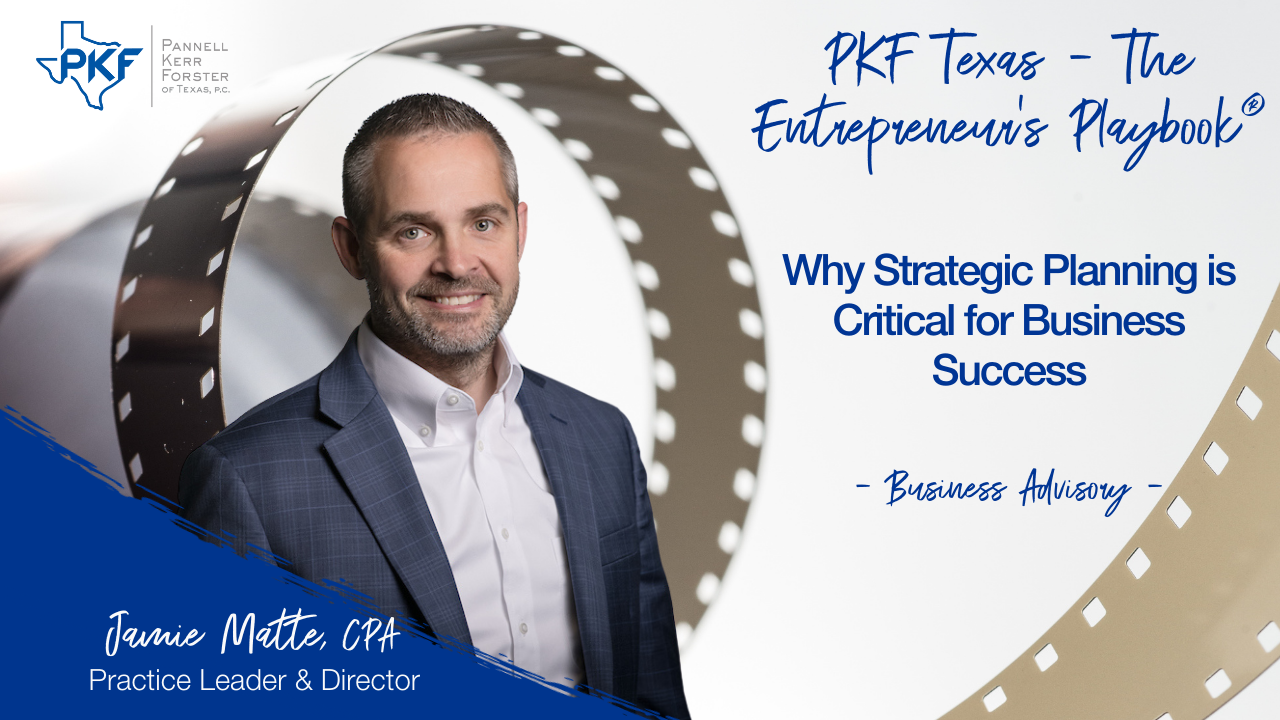Why Strategic Planning is Critical for Business Success

Strategic planning isn’t just for large corporations — it’s a vital roadmap for small and mid-sized businesses aiming for sustainable growth. In this episode of PKF Texas—The Entrepreneurs Playbook®, Jen Lemanski sits down with Jamie Matte, CPA, Business Advisory Director at PKF Texas, to break down the value of annual strategic planning, how to approach it in three practical phases, and the common pitfalls to avoid. Whether you’re new to strategic planning or need a framework to re-energize your efforts, this episode offers expert insights to help align your team and set a clear path forward.
Transcript Below
Jen: This is the PKF Texas – TheEntrepreneurs Playbook®. I’m Jen Lemanski and I’m back once again with Jamie Matte, our business advisory director and one of the Approachable Advisors® here at PKF Texas. Jamie, welcome back to the Playbook.
Jamie: Hi Jen, nice to be here.
Jen: So, business advisory, obviously there’s a lot of things that go into that and I know, I’ve heard you talk about strategic planning and how important that is to kind of small and medium sized businesses. Why should a business even bother with a strategic plan?
Jamie: I think that strategic planning is probably the single most important exercise that a company can go through on an annual basis. Not uncommon for small size businesses that experience an enormous amount of growth in a short period of time just kind of blow right by those periods when they should be doing their planning.
But the benefit of it is ultimately it creates a very clear strategic roadmap for that company. Right. So it’s clarifying the priorities, it’s aligning the resources behind those priorities. It’s identifying challenges, opportunities and plans on how they can take advantage of those opportunities and overcome those challenges, but ultimately creating that clear strategic roadmap.
Jen: So is there a particular approach you recommend when somebody’s doing a strategic planning exercise?
Jamie: Yeah, certainly. So especially for businesses who have never performed or management teams who have never performed those strategic planning process, it can be an overwhelming project, if you will. So what I like to do is I like to kind of break it into three sections. First section is data gathering. Second is going to be organizing and prioritizing.
And the third is going to be building an action plan around those items. So kind of diving into each of those three real quickly. So, you know, data gathering, there’s a number of different exercises and models that can be used, but in a collaborative approach, taking your management team, going through and doing vision mapping, that’s looking at the critical elements of the business.
So think of things like your people, your product, the market, financial. Right. It’s establishing a short term and a long term kind of vision for what each of those different parts might be. Combining that with a SWOT analysis, strengths, weaknesses, opportunities, threats, and applying your business or applying those methodologies to your business, guided brainstorming around those concepts.
So if you think about it, if you have your management team in and you’re working 2, 4, 8 hours through these exercises, that group’s going to come up with a large number of topics, ideas and potential opportunities. That’s where it takes us to the next step. Right. Because most companies don’t have the Resources or the time to address everything that’s on the board or on the wall.
So that’s where the next step comes in, in organizing it and working as a group to prioritize what are the Most important, maybe 3, 5, 7 of those items that we want to place resources and focus behind to achieve in whatever that period of time.
Jen: Kind of like short, medium and long term type situation.
Jamie: That’s correct. Once the group is able to organize, prioritize, then you move to the third step. And I like to call the third step the how. But it’s building the action plan behind each one of those different priorities or strategic targets. So it’s putting a plan behind each one of those and you get much more granular in that step.
Jen: Strategies, goals, tactics. Pretty much.
Jamie: There you go.
Jen: So are there some things that you see that you kind of do’s and don’ts that you see and that would help be helpful during that strategic planning process?
Jamie: Yeah, absolutely. So I mentioned it earlier, but collaboration amongst your management team and your key stakeholders in the organization, because they’re going to be the ones that are going to have to go out and they’re going to be implementing each of these steps and plans to achieve those goals. The second thing is, and it’s a common mistake in that leadership will work together for day, multiple days, develop a plan and it stays in that room.
So first thing I mentioned was it’s a roadmap. Right. Let’s give the roadmap to the entire organization. Let’s share that with the organization so everyone can understand their piece in that roadmap and how we’re going to achieve where we get to. The one kind of pitfall that I always like to suggest is, you know, when working through those three steps, step one is, step two is defining the where.
That’s where we want to go. You want to work to avoid getting caught up in the how when you’re working within each of those steps. So it’s just putting off the how until step three, because that’s what that step is reserved for.
Jen: So how often do you recommend going through a strategic planning exercise? Is that an annual thing? Is it a kind of an every year thing? I know a lot of us saw during COVID that a five year plan was kind of out the window because Covid happened.
Jamie: Absolutely.
Jen: The world changed literally overnight. What do you recommend there?
Jamie: Yeah, so it’s going to depend on the size of the business, the complexity of the business, and your maybe ownership and management structure. But generally speaking, I say once a year you should be doing your management or your strategy session with your entire management team. And that at a minimum is defining, is looking one year out.
You may want to add three years out when you get to a higher level of ownership structure or at the ownership level. That’s where you may be looking kind of longer out, five years and maybe some of your senior management of kind of looking a little further out.
Jen: And then what about accountability? How do you recommend building that into the plan and then who ultimately keeps everybody accountable for doing what they say they’re going to do?
Jamie: Yeah, good point. So again, strategic planning should not be a one time event, right? So you have your strategic planning session typically fourth quarter of the year if you’re in a calendar year. But at a minimum, each quarter, each of those targets should be measured, tracked, and you adjust, you know, on a monthly basis or quarterly basis or whatever a reasonable time period is.
And each of your respective operational groups or departments, you want to break down and bifurcate that plan as it’s applicable to each of those functional units. And you’re tracking and measuring and holding accountable while you’re going through it. One of the things that in the do’s and don’ts that comes to mind is what you want to do is you want to align your rewards with the achievement of your goals.
And that kind of goes to your question of accountability and the different levels that you want to be able to hold accountable within your strategic plan.
Jen: Perfect. Well, I think we could dig into this much deeper, so we’ll need to get you back. Sound good?
Jamie: Yeah, sounds great, Jen. Thank you.
Jen: This has been another Thought Leader Production brought to you by PKF Texas -The Entrepreneur’s Playbook®. For more information about this and other topics, visit pkftexas.com/insights. Tune in next week for another chapter.

